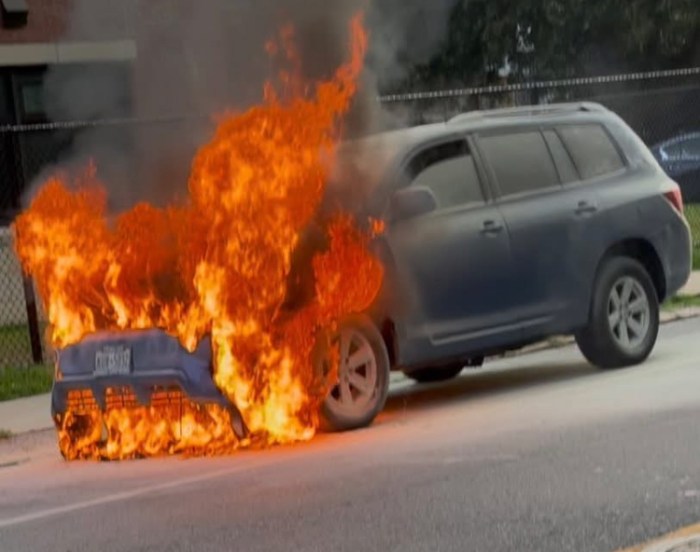Department participates in real ‘burns’ at fire academy in Old Bethpage
As one pulls into the Nassau County Fire Service Academy’s training center in Old Bethpage, he might get the sense that he’s just stumbled onto a Universal Studios set. But when the fire instructor yells, “Action!”, the scene that ensues is as close to real life as possible. Indeed, the training center is one of only a handful of similar centers across the country that use real “burns,” as opposed to gas-fed fires, in its facility – making training for Stewart Manor Fire Department members and dozens of other departments across Nassau County even more intense.
“This is serious stuff,” said SMFD member Bob Barbieri, during a burn the SMFD participated in on Thursday, Oct. 6. The facility has three brick structures – a row of attached stores, garden apartments and a tower-style office building — each with oil-filled palettes inside. Once the oil is set on fire, it will burn and produce smoldering black smoke until the firefighters get it under control. The SMFD, with mutual aid from Franklin Square and Munson Fire Department Ladder Company No. 1, participated in two burns on Oct. 6, a drill the department does three times a year, one night a week for three consecutive weeks.
As the firefighters suited up in their bunker gear, the anxiety level among them was almost tangible. Although they were bracing themselves for a drill, the fire would be real, as would be the possibility of harm to any one of them. Both SMFD ambulances were on hand, in the event of an emergency.
Prior to setting the fire, the fire school instructors gathered the firefighters to brief them. Once the call came in, the department hurried into action. Some members set up an incident command post adjacent to the burning building, while others entered the building. Although they were briefed, they were not told where in the dark, smoky building the fire started and if there were any victims. It was up to them to crawl along the floor and scale the interior walls to find the source of the fire and search for victims – in this case, pieces of rubber hose are used to simulate victims trapped in the fire.
Once the “victims” were removed and the fire was extinguished, the firefighters gathered for a debriefing by the instructors. Despite the autumn chill in the night air, most of the firefighters took off their turncoats and stripped down to t-shirts, as they sat on the outdoor bleachers and drank bottle after bottle of ice water. The temperature inside the burning building reaches upward of 800 to 1,000 degrees, Barbieri said.
“It gets very hot in there. Part of the training is, when you’re in there, fighting a fire, the instructor will [tell you to roll up part of your sleeve near your wrist] to feel the heat,” he said.
After the debriefing, it was time to suit back up for the second burn. Once again, the volunteer firefighters headed into the dark, smoky building to find and extinguish another fire and search for more victims. That was followed by the second debriefing of the night. But the volunteers’ job was not over until they returned to the Stewart Manor firehouse and cleaned their gear until midnight. “This ‘job’ takes a big commitment of time,” Barbieri said.
Time well spent, most members would agree. “As an EMT, I find the drills helpful in preparing for the medical emergencies that frequently occur at fire scenes, usually minor — but not always!” Barbieri remarked. “Also, as a safety officer I get to use the knowledge and skills we [acquire]. There are lots of mandatory classes before you attain different certifications,” he added.
SMFD member Fred Powell agrees. “The training at the Fire Service Academy is invaluable to us. The academy provides real burn conditions for almost any situation that you can imagine [such as vehicle fires, LIRR emergencies, propane fires and Hazmat], and also provides us with the experience that is unmatched by other fire academies,” Powell said. “At the academy, our members experience the challenge of entering a building or situation where you cannot see your hand in front of your face, the feeling of not knowing what is behind the door or wall, [or] what is above or below you. You learn to rely on the use of your other senses such as touch, hearing and instinct. This is what is hard for most, since in the real world we rely on sight in everything we do,” he explained.

































